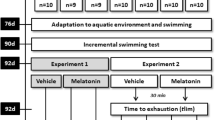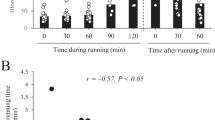Abstract
WE have already shown that functional activity of the brain associated with diffuse neuromuscular activity (physical exertion by swimming) influences numerous biochemical processes in the brain. Certain metabolic processes in the brain are probably used for meeting the energy requirements of the nervous tissue during increased functional activity of the brain connected with the carrying out of physical exertion. This is shown by the fall of the actual concentration of glycogen, glucose and lactic acid in the brain1. Since, during increased functional activity of the brain, an increased amount of ammonia is produced, which is toxic to the nervous tissue, processes of detoxication of ammonia bound by free glutamic acid to free glutamine occur in the brain3. An extensive literature shows that functional activity and various modes of excitement of nervous tissue are always connected with the formation of ammonia2. The sources of ammonia, and the biochemical and physiological significance of the process of ammonia formation in nervous tissue during functional activity, however, have not been definitely established. The present investigation was undertaken to contribute to the clarification of this question.
This is a preview of subscription content, access via your institution
Access options
Subscribe to this journal
Receive 51 print issues and online access
$199.00 per year
only $3.90 per issue
Buy this article
- Purchase on Springer Link
- Instant access to full article PDF
Prices may be subject to local taxes which are calculated during checkout
Similar content being viewed by others
References
Vrba, R., Physiol. Bohemoslov., 3, 122 (1954).
Tashiro, S., Amer. J. Physiol., 60, 519 (1922). Winterstein, H., and Hirschberg, E., Biochem. Z., 156, 138 (1925). Pravdič-Neminskij, B., Arch. Biol. Nauk, 33, 121 (1933). Richter, D., and Dawson, R. M. C., J. Biol. Chem., 176, 1199 (1948).
Vrba, R., Physiol. Bohemoslov., 3, 394 (1954).
Dawson, R. M. C., Biochem. J., 47, 386 (1950).
Richter, D., Brain Metabolism, I, International Neurochemical Symposium (Academic Press, New York, 1955).
Dobry, A., and Sturtevant, J. M., J. Biol. Chem., 195, 141 (1952).
Ushakov, V. P., DAN SSSR., 71, 205 (1950). Romanov, S. N., DAN SSSR., 90, 117 (1953).
Koshtojanc, Ch., Physiol. Bohemoslov., 3, 384 (1954).
Author information
Authors and Affiliations
Rights and permissions
About this article
Cite this article
VRBA, R. A Source of Ammonia and Changes of Protein Structure in the Rat Brain during Physical Exertion. Nature 176, 117–118 (1955). https://doi.org/10.1038/176117a0
Issue Date:
DOI: https://doi.org/10.1038/176117a0
This article is cited by
-
Some aspects of ammonia formation in the brain of dying animals and during recovery after resuscitation
Bulletin of Experimental Biology and Medicine (1977)
-
Ammonia Formation in Brain Cortex Slices
Nature (1957)
Comments
By submitting a comment you agree to abide by our Terms and Community Guidelines. If you find something abusive or that does not comply with our terms or guidelines please flag it as inappropriate.



